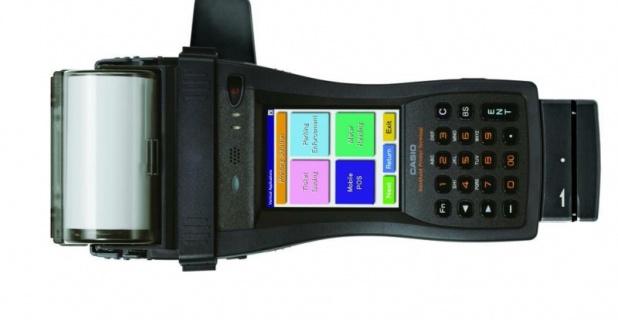Whether on the bus, the train or at an open-air concert, the high-speed thermal printer and optional magnetic card reader (model M54E/M55E) as well as the easily readable display make the IT-3100 data terminal ideally suited for use in the field of mobile sales and ticketing. The sturdy terminal takes daily industrial rough and tumble in its stride and also feels at home in dirty and wet environments. The Bluetooth® and IrDA interfaces as well as a PC card and SD card slot offer a range of expansion options, as well as use in a WLAN and GPRS environment.
The highest level of efficiency, perfect ergonomics - anytime, anywhere
The IT-3100 is setting new standards - and not only in the field of mobile sales and ticketing. Wherever wide-ranging possibilities combined with reliability, ergonomics, low weight and real outdoor capabilities are called for, the hand-held terminal ensures greater efficiency through minimisation of mistakes and highly-secure data storage.
Excellent range of connections and interfaces
A plug-in position for SD cards (SDHC) and PC cards (Type I/II), an IrDA and the integrated Bluetooth® interface are already standard in the IT-3100. If required, the data saved in the terminal can be transferred to an SDHC card. Wireless LAN and UMTS communication via the PC card slot is possible with an optional PCMCIA or CF card. The integrated Bluetooth® module allows wireless communication via mobile phones, Bluetooth® access points and much more. Two serial interfaces (8-pin, 14-pin) for connecting external modules such as a Smart Card reader are also available.
Sophisticated design and simple operation down to the last detail
The integrated high-performance, high-speed thermal printer impresses with its high printing speed and quality. It prints up to 28 lines per second. Users also enjoy the quick and simple paper roll replacement - simply open the cover, insert a new paper roll, pull out a little of the paper and shut the cover - finished. The design of the IT-3100 housing combines a large touch display with a slim, ergonomic device shape. An elastic strap on the back of the device means that the terminal can be held easily with one hand and guarantees fatigue-free use over many hours.
Microsoft Windows® CE 5.0
The IT-3100 works with Windows® CE 5.0 as its operating system. It guarantees simple integration into existing and state-of-the-art solutions and provides the best possible support for communication via Bluetooth®, Wireless LAN or GPRS. The Microsoft Compact Framework is supported and applications can be developed with eVC++4.0 or Microsoft Visual Studio.
Built for use in harsh conditions
The IT-3100 can withstand even the harshest operating conditions: it can survive a fall of 1.2 metres on to concrete, it is splash-proof and dust-proof in accordance with IP 54 and works perfectly in sun, rain or snow within a temperature range of -20°C and +50°C. Because of this, the terminal is ideally suited for use in logistics services, mobile sales, the service sector, ticketing solutions, courier services, shipping as well as for internal applications in industry and trade.
Top-class readability from the display and keypad
The transflective colour LCD of the IT-3100 provides a high-quality two-way TFT colour LCD with 240 x 320 pixels. The special CASIO display technology enables outstanding display clarity even in blazing sunshine. The light is reflected by foil, helping to improve the background lighting. Even the keyboard of the IT-3100 is equipped with background lighting. It is controlled by a brightness sensor and turns on automatically if required.
Power Management
The IT-3100 draws its energy from the power supply (100-240V) and the integrated lithium ion storage battery (7.4V, 2200mAh). Excellent power management enables the lowest possible level of electricity consumption, resulting in longer operating times. A back-up battery is integrated, offering additional security for user data. Future additions to the range of functions can simply be transferred by software into the high-performance terminal. This is made possible by the battery-independent memory











